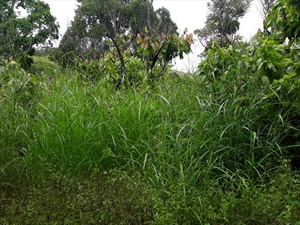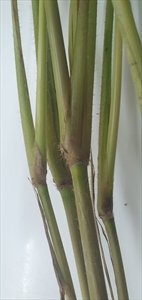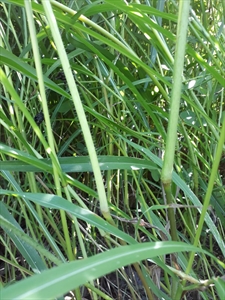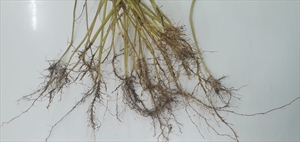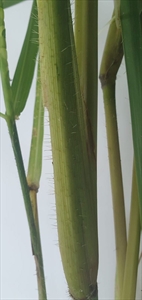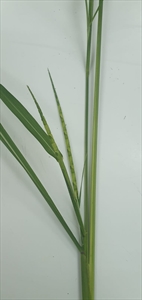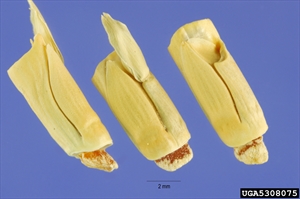- Widespread. Asia, Africa, North, South and Central America, Caribbean, Oceania. In Australia, Fiji, PNG, Solomon Islands.
- Aggressive grass of open, well-drained sites, along roads, railways, but also wet places, including shallow water. Invasive in soybean, corn, cotton, peanut, upland rice, sugarcane. Plants produce many thousands of seeds, and thrive under a range of environmental conditions. Alternative host for maize viruses (Maize mosaic nucleorhabdovirus; see Fact Sheet no. 074). Hairs damage skin.
- Stems, cylindrical, hollow, branching at upper nodes, with basal prop roots, and multiple tillers. Leaves, blue-green, 5-20 mm wide, with conspicuous pale mid-vein. Silica hairs on leaf sheath cause the itch. Flowers, on spikes, up to 15 cm long, single or in groups of 3-4, arising from leaf axils at top of the stem. As spikes mature, the cylindrical rice-size seeds progressively break free starting at furthest end.
- Spread: seeds, by birds, floodwater, rodents, farm machinery; along transport routes; contaminant of rice and legume seed.
- Biosecurity: high risk of introduction; one of the 12 worst weeds of sugarcane, and a competitive weed of maize. On Global Invasive Species Database of alien invasive species (IUCN, 2020).
- Biocontrol: several fungi have potential as mycoherbicides.
- Cultural control: hand weed; slashing; cultivation (plus use herbicide); interplant food legumes with maize; vehicle hygiene; IPM - fire, plough, fallow.
- Chemical control: in Australia: hexazinone + diuron. In Fiji, glyphosate; diuron.
Pacific Pests, Pathogens and Weeds - Online edition
Pacific Pests, Pathogens, Weeds & Pesticides
Itch grass (458)
Itch grass
Rottboellia cochinchinensis; it was known previously as Rottboellia exaltata. It is a member of the Poaceae.
AUTHORS Grahame Jackson, Aradhana Deesh & Mani Mua
Information from CABI (2019) Rottboellia cochinchinensis (itch grass). Invasive Species Compendium. (https://www.cabi.org/isc/datasheet/47782); and Itchgrass Rottboellia cochinchinensis (2014) Texas Invasive Species Institute.(http://www.tsusinvasives.org/home/database/rottboellia-cochinchinensis); and from Global Invasive Species Database (2020) Species profile: Rottboellia cochinchinensis. (http://www.iucngisd.org/gisd/species.php?sc=772). Photo 9 Steve Hurst, USDA NRCS PLANTS Database, Bugwood.org.
Produced with support from the Australian Centre for International Agricultural Research under project HORT/2016/185: Responding to emerging pest and disease threats to horticulture in the Pacific islands, implemented by the University of Queensland, in association with the Pacific Community and Koronivia Research Station, Ministry of Agriculture, Fiji.
